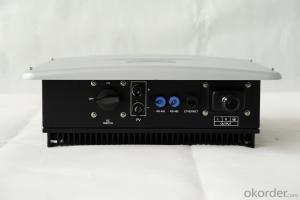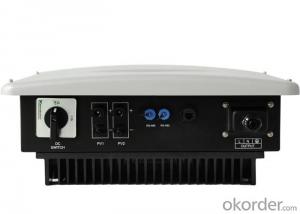Easun Solar Inverter Sununo-TL1K with 1MPPT Ongrid
- Loading Port:
- Guangzhou
- Payment Terms:
- TT OR LC
- Min Order Qty:
- 1 pc
- Supply Capability:
- 3000 pc/month
OKorder Service Pledge
OKorder Financial Service
You Might Also Like
The Sununo-TL1K/1.5K/2K solar inverter offers a range of benefits, including maximum energy harvesting,
through both its highspeed Maximum Power Point Tracker (MPPT) and transformerless technology.Combing the wide input voltage range makes the inverter suitable to low power installations with reduced string size.
The LCD display is to check real-time performance through its integrated data logger and more communication interfaces make it convenient for remote performance monitoring. The Sununo-TL1K/1.5K/2K is an ideal inverter for smaller residential PV plants.
Futures:
■Super junction MOSFET integrated with 97.4% Max. efficiency.
■ Wide MPPT voltage range and low minimum MPPT voltage for flexible configuration.
■ Transformerless design for lower cost and compact size.
■ IP65 and fan-less for longer-term reliability.
■ Ethernet/ Wi-Fi communication interface.
■ Integrated Web Server for local and internet monitoring.
■ Support SAJ Web Portal Monitoring Solutions.
Technical data:
| Model | Sununo-TL1K | Sununo-TL1.5K | Sununo-TL2K |
| Max. DC power [W] | 1200 | 1800 | 2300 |
| Max. DC voltage [V] | 480 | 480 | 480 |
| MPPT DC voltage Range [V] | 90-425 | 100-425 | 100-425 |
| Nominal DC voltage [V] | 360 | 360 | 360 |
| start voltage [V] | 100 | 150 | 150 |
| Min.DC voltage [V] | 80 | 100 | 100 |
| Max.DC input current [A] | 10 | 11 | 12 |
| Number of MPPT | 1 | 1 | 1 |
| string per MPPT | 1 | 1 | 1 |
| DC switch | optional | optional | optional |


1. How long will my inquiry get response?
Your inquiry related to our products or prices will be replied within 24 hours.
2. Can I get professional service and suggestion?
Well-trained and experienced staffs to answer all your questions in fluent English.
3. Do you accept OEM or customized design?
OEM & ODM, any your customized lightings we can help you to design and put into product.
4. What if I need specific design?
Distributorship are offered for your unique design and some our current models.
- Q: How do you calculate the efficiency loss due to temperature for a solar inverter?
- To calculate the efficiency loss due to temperature for a solar inverter, you need to determine the temperature coefficient of the inverter. This coefficient represents the rate at which the inverter's efficiency decreases with an increase in temperature. Once you have the temperature coefficient, you can calculate the efficiency loss by multiplying it with the difference between the actual operating temperature and the reference temperature. The reference temperature is typically the standard test condition temperature, which is usually around 25 degrees Celsius. The formula to calculate the efficiency loss is as follows: Efficiency Loss = Temperature Coefficient × (Operating Temperature - Reference Temperature) By plugging in the appropriate values, you can determine the efficiency loss due to temperature for a solar inverter.
- Q: Can a solar inverter be used with a solar-powered water pumping system?
- Yes, a solar inverter can be used with a solar-powered water pumping system. The solar inverter converts the direct current (DC) produced by the solar panels into alternating current (AC), which is necessary to power the water pump. By utilizing a solar inverter, the energy generated by the solar panels can be efficiently transferred to the water pumping system, allowing it to operate using clean and renewable energy.
- Q: How does the voltage regulation affect the performance of a solar inverter?
- Voltage regulation plays a crucial role in the performance of a solar inverter. It ensures that the output voltage of the inverter remains stable and within an acceptable range, regardless of fluctuations in the input voltage. This stability is vital for the efficient operation of the inverter and the overall performance of the solar power system. Improper voltage regulation can lead to various issues such as increased power losses, reduced energy production, and potential damage to connected devices.
- Q: How long does a solar inverter last?
- A solar inverter typically has a lifespan of around 10 to 15 years, although this can vary depending on various factors such as the quality of the inverter, its usage, and maintenance.
- Q: Can a solar inverter be used with different monitoring platforms?
- Yes, a solar inverter can be used with different monitoring platforms as long as the monitoring platforms are compatible with the inverter's communication protocols and data formats.
- Q: Can a solar inverter be used with a generator as a backup power source?
- Yes, a solar inverter can be used with a generator as a backup power source. The solar inverter can be connected to the generator's power output, allowing it to convert the generator's AC power into usable DC power for the solar panels. This enables the solar panels to continue generating electricity even when there is no sunlight, providing a reliable backup power supply.
- Q: Can a solar inverter be used in systems with different module orientations?
- Yes, a solar inverter can be used in systems with different module orientations. Solar inverters are designed to convert the direct current (DC) generated by the solar panels into alternating current (AC) that can be used to power electrical devices. They are compatible with various module orientations, including both portrait and landscape orientations. However, it is important to consider the efficiency and performance of the solar system when installing modules with different orientations, as it may affect the overall energy production.
- Q: Can a solar inverter be used in systems with different module strings?
- Yes, a solar inverter can be used in systems with different module strings. Solar inverters are designed to convert the direct current (DC) generated by solar panels into alternating current (AC) that can be used to power homes or businesses. They are typically compatible with a wide range of module string configurations, allowing for flexibility in system design and installation. However, it is important to ensure that the solar inverter's power rating and specifications are suitable for the combined power output of the module strings to ensure optimal performance.
- Q: Are there any maintenance requirements for solar inverters?
- Yes, there are maintenance requirements for solar inverters. While solar inverters are generally reliable and require minimal maintenance, regular inspections and maintenance are still necessary to ensure optimal performance and longevity. Some common maintenance tasks for solar inverters include: 1. Regular cleaning: Dust, dirt, and debris can accumulate on the surface of the inverter, potentially affecting its cooling capabilities. Regular cleaning helps to prevent overheating and ensures efficient operation. 2. Visual inspection: Regularly inspecting the inverter for any signs of damage, loose connections, or corrosion is important. This can be done visually to identify any issues that may affect its performance. 3. Firmware updates: Manufacturers often release firmware updates to improve the performance and functionality of the inverter. It is recommended to regularly check for and install these updates to ensure the inverter is operating at its best. 4. Monitoring system performance: Utilizing a monitoring system allows for the continuous monitoring of the inverter's performance. Any abnormalities or issues can be identified promptly, enabling quick maintenance or repair. 5. Professional maintenance: It is advisable to have a professional solar technician inspect and maintain the inverter at least once a year. They can perform more in-depth inspections, test the inverter's electrical connections, and troubleshoot any potential issues. By following these maintenance requirements, solar inverters can continue to operate efficiently and reliably, maximizing the benefits of solar energy production.
- Q: What is the role of a power control unit in a solar inverter?
- The role of a power control unit in a solar inverter is to regulate and control the flow of electricity from the solar panels to the electrical grid or to the connected load. It ensures efficient power conversion by managing voltage, current, and frequency, and provides protection against overvoltage, under voltage, and short circuits. Additionally, the power control unit may also include features like maximum power point tracking (MPPT) to optimize the energy output from the solar panels.
Send your message to us
Easun Solar Inverter Sununo-TL1K with 1MPPT Ongrid
- Loading Port:
- Guangzhou
- Payment Terms:
- TT OR LC
- Min Order Qty:
- 1 pc
- Supply Capability:
- 3000 pc/month
OKorder Service Pledge
OKorder Financial Service
Similar products
Hot products
Hot Searches
Related keywords
























